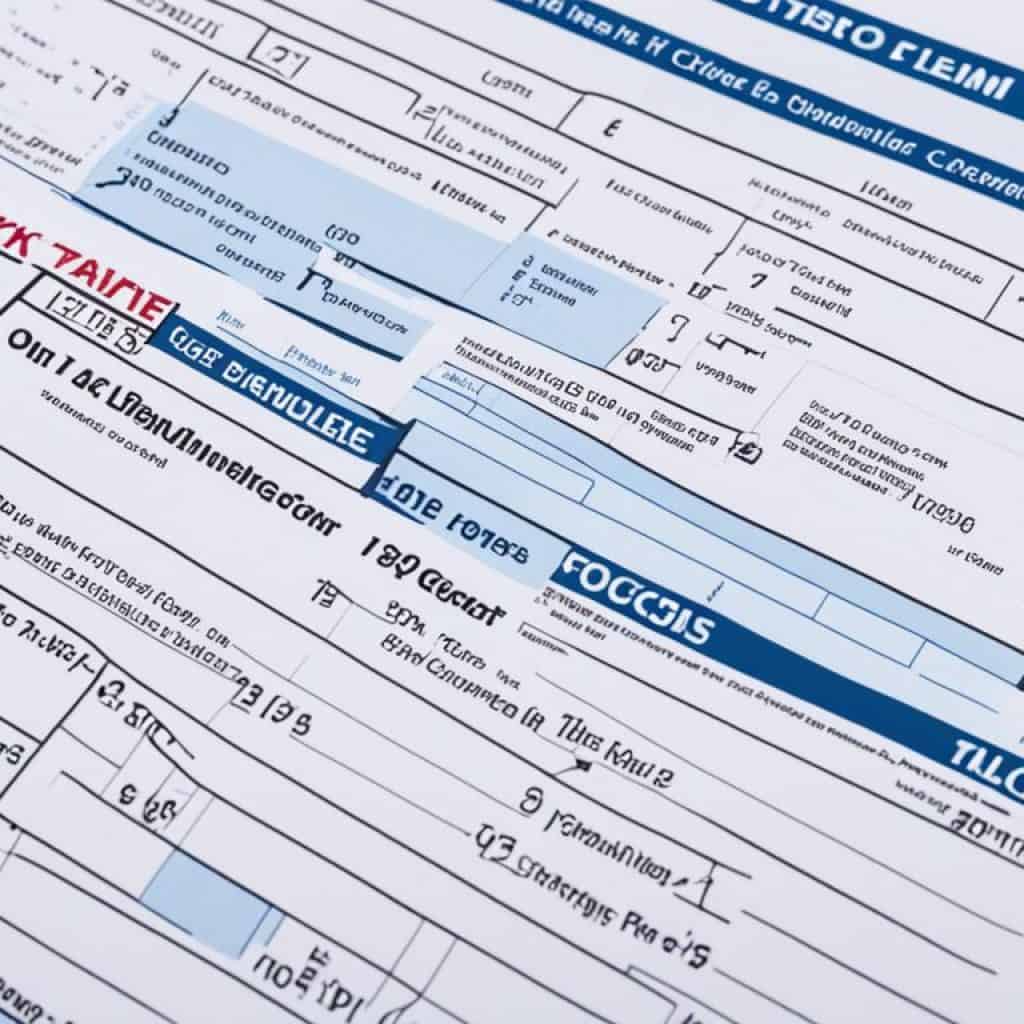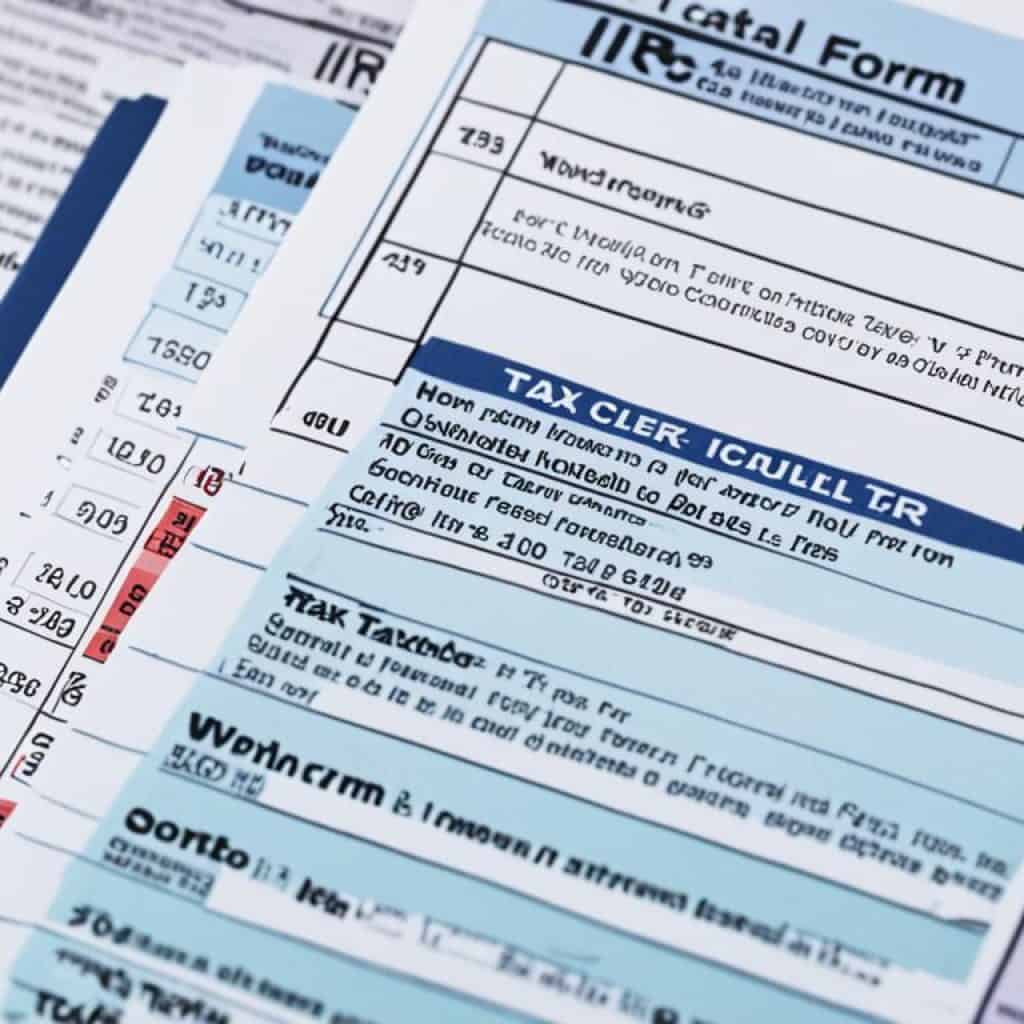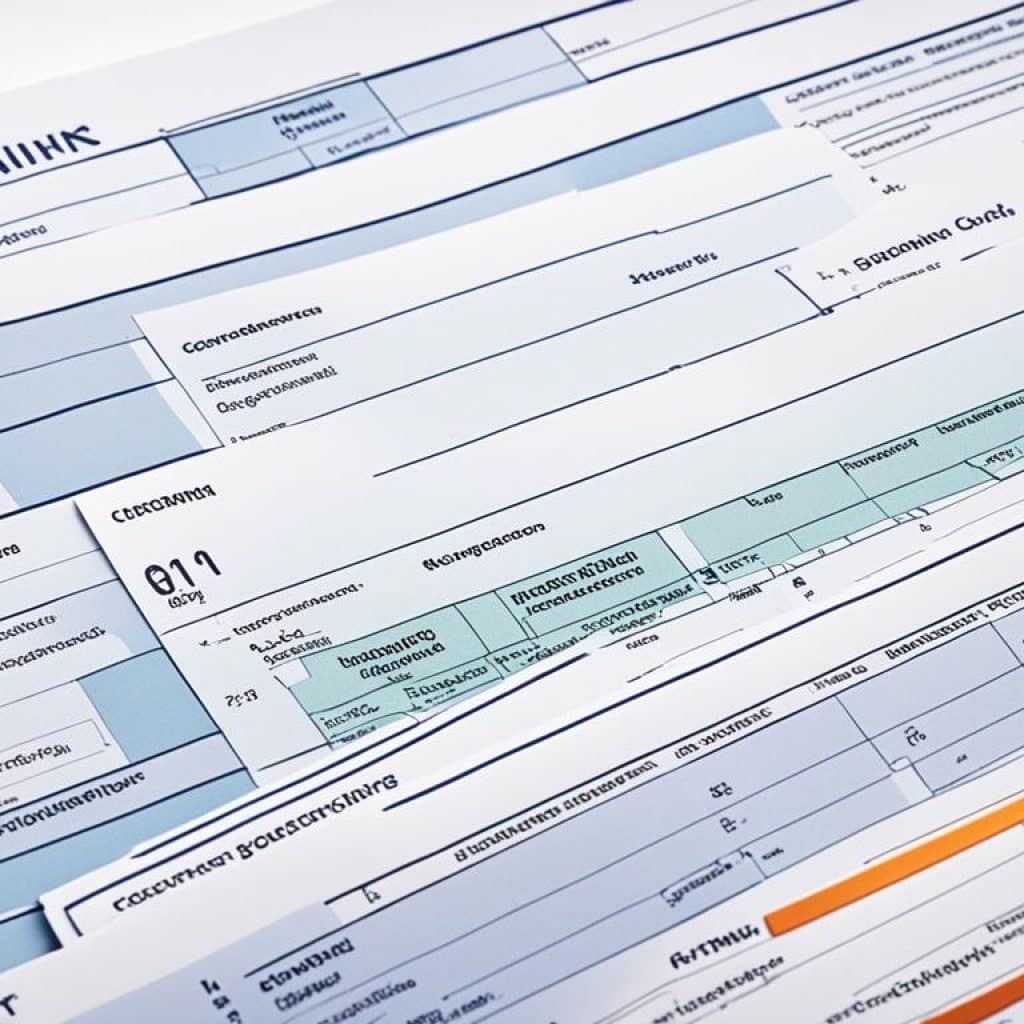Have you ever wondered what the mysterious K-1 form is all about when it comes to tax filing? What does it mean, and why is it important? Prepare to unravel the secrets of the K-1 and gain a deeper understanding of how it impacts your tax obligations.
If you are a partner, shareholder, or beneficiary of a business or financial entity, the K-1 form is a crucial document that you need to navigate. It allows you to report your income, losses, and dividends accurately and fulfill your filing requirements. But what exactly is the K-1, and how does it work?
Key Takeaways:
- The K-1 form is a federal tax document used for reporting income, losses, and dividends for partners or shareholders in a business or financial entity.
- It is also used to report income distributions from trusts and estates to beneficiaries.
- The K-1 form is essential for individuals to understand their income distributions and meet their filing requirements.
- The information in the K-1 form is used to calculate the tax liability and income of partners, shareholders, and beneficiaries.
- Understanding the K-1 form is crucial for accurate tax filing and compliance with IRS regulations.
Key Takeaways from Schedule K-1
When it comes to tax reporting, partners, shareholders, and beneficiaries need to understand the importance of Schedule K-1. This federal tax document plays a crucial role in accurately reporting earnings, losses, and dividends. Here are some key takeaways:
- Schedule K-1 is issued by pass-through entities: Pass-through entities, such as partnerships and S corporations, use Schedule K-1 to shift the tax liability and income to their stakeholders. It ensures that each participant’s share of the business’s financials is properly reported.
- Tracking ownership stake: Schedule K-1 requires tracking each participant’s ownership stake in the business. This ensures that the income and losses are allocated correctly based on the individual’s investment or interest in the entity.
- Reporting various types of income: Schedule K-1 allows for the reporting of various types of income, including rental income, interest, and dividends. It provides a comprehensive overview of the financial aspects of the business and ensures accurate reporting.
- Timely issuance: Schedule K-1s should be issued to taxpayers by March 15 or the third month after the entity’s fiscal year. This allows individuals to incorporate the information into their personal tax filings in a timely manner.
“Schedule K-1 is an essential tool for partners, shareholders, and beneficiaries to accurately report their earnings, losses, and dividends. It provides transparency and ensures compliance with tax regulations.”
To better understand these key takeaways, let’s take a look at a sample Schedule K-1 form:
Sample Schedule K-1 Form
| Partnership Name: | ABC Partnership |
|---|---|
| Partner Information: | John Smith |
| Ownership Stake: | 30% |
| Income: | $50,000 |
| Losses: | $10,000 |
| Dividends: | $2,000 |
Understanding Schedule K-1 is crucial for accurate tax reporting. By tracking earnings, losses, and dividends, partners, shareholders, and beneficiaries can fulfill their tax obligations and ensure compliance with IRS regulations.
Understanding Schedule K-1 in Tax Filing
The U.S. federal tax code provides a pass-through strategy that allows the tax liability of an entity to be shifted from the entity itself to the individuals who have an interest in it. This strategy is commonly used by partnerships, S corporations, and certain other types of businesses. When it comes to tax filing, Schedule K-1 plays a crucial role in reporting the earnings, income, deductions, credits, and distributions for each participant.
Partners and shareholders need to understand how Schedule K-1 affects their tax filing obligations. This comprehensive tax document ensures that the tax reporting accurately reflects the individual’s share of the entity’s financial activity.
By using Schedule K-1, participants can report the following:
- Earnings
- Income
- Deductions
- Credits
- Distributions
The information provided on Schedule K-1 serves as the foundation for determining the individual’s tax liability and fulfilling their tax obligations. It is crucial to correctly complete this form in order to accurately report the share of earnings, deductions, and other financial aspects related to the entity.
Here is an example of how Schedule K-1 can be structured:
| Partnership | Partner Information | Share of Income | Deductions |
|---|---|---|---|
| ABC Partnership | John Smith | $50,000 | $10,000 |
| ABC Partnership | Jane Doe | $30,000 | $5,000 |
Please note that this is a simplified example for illustrative purposes only.
Understanding Schedule K-1 and its implications is essential for partners and shareholders when it comes to accurate tax reporting. By mastering the intricacies of this tax document, individuals can ensure compliance with tax laws and optimize their tax strategies.
Aspects of Schedule K-1
In order to understand the intricacies of Schedule K-1, it is important to delve into the various aspects that make up this crucial tax form. Partnership agreements play a significant role in shaping the information reported on Schedule K-1. Additionally, the basis calculation helps track each partner’s investment or ownership stake in the partnership. Finally, partners can earn different types of income, such as rental income, bond interest, and stock dividends, all of which must be accurately reported on Schedule K-1.
Partnership Agreements and Schedule K-1
Partnership agreements serve as the foundation for any partnership, outlining the rights, responsibilities, and rules that partners must adhere to. These agreements have a direct impact on the information reported on Schedule K-1. They determine how income, losses, deductions, and credits are allocated among partners and provide the framework for calculating each partner’s share of the partnership’s financial activities. By understanding the terms of the partnership agreement, partners can ensure accurate reporting on Schedule K-1.
Basis Calculation for Schedule K-1
The basis calculation is a crucial component of Schedule K-1, as it tracks each partner’s investment or ownership stake in the partnership. This calculation helps determine the partner’s basis in the partnership, which is essential for accurately reporting income, losses, and deductions. The basis calculation takes into account capital contributions, distributions, and any other changes to the partner’s financial position within the partnership. Partners must have a clear understanding of the basis calculation to ensure the accurate reporting of their share of the partnership’s activities on Schedule K-1.
Income Reporting on Schedule K-1
Partners can earn various types of income within a partnership, and it is essential to accurately report these income sources on Schedule K-1. This includes rental income from real estate holdings, bond interest from investments, and stock dividends from portfolio holdings. By properly reporting these sources of income on Schedule K-1, partners can fulfill their tax obligations and ensure compliance with tax laws.
| Aspect | Description |
|---|---|
| Partnership Agreements | Determine the rules and allocations for income, losses, deductions, and credits among partners. |
| Basis Calculation | Tracks each partner’s investment or ownership stake in the partnership. |
| Income Reporting | Includes rental income, bond interest, and stock dividends, among other sources of income. |
Types of Schedule K-1s
When it comes to Schedule K-1 forms, there are different types available, depending on the type of entity involved. Here’s an overview of the various Schedule K-1 forms:
Partnerships
Partnerships issue Schedule K-1s to both the IRS and individual partners. This form ensures that partners receive accurate information regarding their share of partnership income, losses, deductions, and credits.
S-corporations
S-corporations include Schedule K-1 information in their annual tax return. This form helps shareholders understand their portion of the corporation’s income, losses, deductions, and credits.
Trusts and Estates
For trusts and estates, Schedule K-1 is used to report income to beneficiaries. It provides a breakdown of the income earned, as well as any deductions, credits, and distributions that may apply.
Overall, these different types of Schedule K-1 forms ensure that the appropriate information is reported to the relevant parties, allowing for accurate tax reporting and compliance.
Who Files a Schedule K-1?
– Individual taxpayers do not usually file Schedule K-1, but they use the information on the form to prepare their income tax returns.
– Partners, shareholders, and beneficiaries are responsible for incorporating Schedule K-1 into their tax filings.
– The partnership, S-corporation, or trust/estate files a copy of Schedule K-1 with the IRS.

A detailed table identifying the entities that file a Schedule K-1 and the individuals who receive it is as follows:
| Entity | Filers | Recipients |
|---|---|---|
| Partnership | Partners | Individual partners, IRS |
| S-Corporation | Corporation | Shareholders |
| Trust/Estate | Trust/Estate | Beneficiaries |
Partnership
- Filers: Partners
- Recipients: Individual partners, IRS
S-Corporation
- Filers: Corporation
- Recipients: Shareholders
Trust/Estate
- Filers: Trust/Estate
- Recipients: Beneficiaries
What is IRS Schedule K-1?
IRS Schedule K-1 is a vital tax form used for reporting income, gains, losses, and distributions from investments or business entities. It plays a crucial role in the tax filing process, specifically for pass-through entities that do not pay corporate tax. By using Schedule K-1, participants can accurately calculate their income and determine the tax due on it.
Unlike traditional corporate entities, pass-through entities distribute their income directly to stakeholders or investors. This distribution is then taxed at the individual level. Schedule K-1 provides the necessary information to individuals to accurately report their share of income, gains, losses, and distributions from these entities.
Participants use the data provided on Schedule K-1 to fill out their tax returns, ensuring compliance with tax regulations and reporting requirements. It allows them to calculate their taxable income effectively and fulfill their tax obligations to the IRS.
Understanding and correctly incorporating IRS Schedule K-1 into your tax filing is crucial for accurately reporting your income from investments and business entities. If you need assistance or have questions regarding Schedule K-1, it’s recommended to consult with a tax professional or CPA who can provide personalized guidance.
Who Gets an IRS Schedule K-1?
IRS Schedule K-1 is a crucial tax document that is typically received by a variety of individuals and entities. The recipients of IRS Schedule K-1 include:
- S corporation shareholders
- Partners in business partnerships
- Investors in limited partnerships
- Beneficiaries of trusts and estates
These individuals and entities receive IRS Schedule K-1 in order to report their income, losses, deductions, and other distributions they may have received. Whether you are a shareholder, partner, investor, or beneficiary, properly reporting this information is essential for accurate tax filing.
| Recipient | Entity Type |
|---|---|
| S Corporation Shareholders | S corporations |
| Partners | Business partnerships |
| Investors | Limited partnerships |
| Beneficiaries | Trusts and estates |
Image: 
Is IRS Schedule K-1 Income Considered Earned Income?
The classification of IRS Schedule K-1 income as earned or unearned depends on the individual’s participation and status. For general partners and active owners, the income can be considered earned income, subject to self-employment tax. Limited partners and passive investors may consider IRS Schedule K-1 income as unearned income.
| Income Classification | Definition |
|---|---|
| Earned Income | Income derived from active participation and involvement, such as general partners and active owners |
| Unearned Income | Income received without active involvement, including limited partners and passive investors |
Earned income from IRS Schedule K-1 is subject to self-employment tax, which includes Social Security and Medicare taxes for individuals who are considered self-employed. It is important for individuals to understand their income classification to accurately calculate their taxes and meet the reporting requirements.
Consulting with a tax professional or CPA can provide personalized advice and guidance on how to handle IRS Schedule K-1 income for proper tax filing.
When Should I Receive My IRS Schedule K-1?
As a taxpayer, you may be wondering when you should expect to receive your IRS Schedule K-1. This important tax form, which reports income, gains, losses, and distributions, is typically due by March 15th or the 15th day of the third month after the entity’s tax year ends.
It’s important to note that the deadline for receiving your Schedule K-1 may vary, and it’s not uncommon for it to arrive later than expected. Factors such as complex partnership structures and the processing time for the form can contribute to delays. However, you should generally expect to receive your Schedule K-1 by the designated deadline.
Once you have received your IRS Schedule K-1, you can use the information provided to accurately calculate your income and fulfill your tax obligations. If you have any questions or require assistance in incorporating the Schedule K-1 into your tax filing, it’s recommended to consult with a tax professional or a certified public accountant (CPA).
What is the K-1 Tax Form?
The K-1 tax form is an essential document for individuals who have private investments in entities such as Limited Partnerships (LLPs), Limited Liability Corporations (LLCs), and certain Exchange-Traded Funds (ETFs). It serves as a means to report earnings, losses, and dividends from these investments, ensuring compliance with IRS regulations and fulfilling tax obligations.
Private investments offer individuals the opportunity to participate in various business ventures, partnerships, and funds. These investments often generate income, and the K-1 tax form provides a structured way to report this income accurately. By reporting their income on the K-1 form, individuals can fulfill their tax obligations and maintain compliance with IRS regulations.
The K-1 tax form is particularly relevant for entities such as LLPs, LLCs, and certain ETFs. These investment vehicles operate as pass-through entities, meaning that the income generated by the entity is passed on to the investors or partners who hold ownership stakes. The K-1 form allows these investors to report their share of earnings, losses, and dividends to the IRS.
Understanding the K-1 tax form is crucial as it ensures individuals accurately report their income and provides transparency in tax filings. By properly completing the K-1 form, individuals can meet their tax obligations and avoid potential penalties or audits.
Now that we have explored what the K-1 tax form is and its significance for reporting earnings from private investments, let’s delve deeper into the different parts of the form and how to navigate its complexities.
What are the Parts of the K-1 Form?
When completing your K-1 form, it’s important to understand its structure and the information it contains. The K-1 form consists of three parts: Part I, Part II, and Part III. Each part serves a specific purpose in providing the necessary partnership and partner information for accurate tax reporting.
Part I: Partnership Information
Part I of the K-1 form focuses on providing essential details about the partnership itself. This includes the partnership’s name, address, and Employer Identification Number (EIN). This section is crucial for accurately identifying the partnership being reported and ensuring proper record keeping.
Part II: Partner Information
Part II is dedicated to partner information. It includes details about the partner or shareholder, such as their ownership stake in the partnership and beginning/ending balances. This section helps establish the partner’s financial involvement and tracks any changes throughout the tax year.
Part III: Share of Income, Deductions, and Other Items
Part III provides a breakdown of the partner’s share of income, deductions, credits, and other items. It highlights specific details regarding the partner’s financial involvement in the partnership, including their share of profits, losses, and deductible expenses. This section plays a crucial role in determining the partner’s taxable income and ensures accurate reporting.
Understanding the different parts of the K-1 form is essential to correctly report partnership income, deductions, and other items. Make sure to review each part carefully and consult with a tax professional if you have any questions or need further guidance.

Why is the K-1 Form Complicated?
The K-1 form can be quite complex due to its various parts and the involvement of different types of pass-through entities. This complexity poses challenges for tax and accounting firms that handle K-1 forms, as they need to navigate non-standard formats, intricate information, and the implications of state, federal, and international taxes. Additionally, the presence of tiered partnership structures further adds to the complexity of the K-1 form.
What to Do with Your K-1 Form
Once you have received your K-1 form, it’s important to take the necessary steps to incorporate the information into your tax filing. Here are the key actions to follow:
- Enter the information provided on your K-1 form onto your IRS Form 1040 when filing your taxes. This allows you to accurately report your earnings, losses, and dividends.
- Ensure that you accurately input all the relevant details from your K-1 form onto the appropriate sections of your IRS Form 1040. This will help you calculate your taxable income correctly and avoid any potential discrepancies.
- If you have any questions or need assistance with understanding the information on your K-1 form, it’s advisable to consult with a tax professional or certified public accountant (CPA). They can provide personalized guidance and ensure that you correctly incorporate the K-1 form into your tax filing.
By adhering to these steps, you can navigate the process of including your K-1 form information in your tax filing effectively and accurately.
Does a K-1 Count as Income?
The K-1 form itself does not count as income. It serves as a reporting tool for the income you earned from your investments. The information provided on the K-1 form is then included on your IRS Form 1040 to calculate your taxable income.
| Income Source | Taxable or Non-Taxable |
|---|---|
| Interest income | Taxable |
| Dividend income | Taxable |
| Capital gains | Taxable |
| Rental income | Taxable |
| Ordinary business income | Taxable |
| Non-business income | Non-taxable |
It is important to accurately report the income from your K-1 form on your IRS Form 1040 to ensure compliance with tax regulations and determine your tax liability.
Understanding Taxable Income
Taxable income refers to the portion of your income that is subject to taxation. It is calculated by subtracting any eligible deductions and exemptions from your total income. The taxable income determines the amount of income tax you owe to the IRS.
“Properly reporting your K-1 income is crucial for accurately calculating your taxable income and fulfilling your tax obligations.”
Consult with a tax professional or CPA to ensure you correctly include the income from your K-1 form on your IRS Form 1040 and maximize your tax benefits.
Conclusion
In conclusion, understanding Schedule K-1 is essential for partners, shareholders, and beneficiaries to accurately report their earnings, losses, and dividends. This federal tax form plays a vital role in tax filing for pass-through entities and provides a clear picture of income distributions.
When it comes to incorporating Schedule K-1 into your tax filing, it is always recommended to consult with a tax professional. They can provide personalized advice and assistance to ensure that you correctly handle and report your income on this form.
By understanding the importance of Schedule K-1 and seeking expert guidance, you can confidently navigate the complexities of tax filing and fulfill your obligations with ease.
FAQ
What is a K-1?
A K-1 is a federal tax document used to report income, losses, and dividends for partners or shareholders in a business or financial entity. It is also used to report income distributions from trusts and estates to beneficiaries.
Who uses Schedule K-1?
Partners, shareholders, and beneficiaries use Schedule K-1 to report their earnings, losses, and dividends.
What is the purpose of Schedule K-1?
Schedule K-1 is issued by pass-through entities that shift the tax liability and income to their stakeholders. The form requires tracking each participant’s ownership stake in the business and reporting their share of income, deductions, credits, and other items.
What types of income can be reported on Schedule K-1?
Partners can earn various types of income, including rental income, bond interest, and stock dividends, which are reported on Schedule K-1.
When should Schedule K-1s be issued?
Schedule K-1s should be issued to taxpayers by March 15 or the third month after the entity’s fiscal year.
Who files a Schedule K-1?
Partnerships issue K-1s to both the IRS and individual partners. S-corporations include Schedule K-1 information in their annual tax return. Trusts and estates use Schedule K-1 to report income to beneficiaries. Individual taxpayers do not usually file Schedule K-1, but they use the information on the form to prepare their income tax returns.
What is IRS Schedule K-1?
IRS Schedule K-1 is a tax form used to report income, gains, losses, and distributions from investments or business entities. It is used for pass-through entities that do not pay corporate tax, as the income is passed on to stakeholders or investors.
Who receives an IRS Schedule K-1?
IRS Schedule K-1 forms are usually received by S corporation shareholders, partners in business partnerships, investors in limited partnerships, and beneficiaries of trusts and estates. It is used to report the income, losses, deductions, and other distributions they may have received.
When is the deadline to file IRS Schedule K-1?
IRS Schedule K-1 forms are typically due by March 15th or the 15th day of the third month after the entity’s tax year ends.
Is IRS Schedule K-1 income considered earned income?
The classification of IRS Schedule K-1 income as earned or unearned depends on the individual’s participation and status. For general partners and active owners, the income can be considered earned income, subject to self-employment tax. Limited partners and passive investors may consider IRS Schedule K-1 income as unearned income.
What are the parts of the K-1 form?
The K-1 form consists of three parts: Part I, Part II, and Part III. Part I contains information about the partnership, including its name and address. Part II includes information about the partner or shareholder, such as their ownership stake and beginning/ending balances. Part III details the partner’s share of income, deductions, credits, and other items.
How is the K-1 form complicated?
The K-1 form can be complicated due to its various parts and the different types of pass-through entities involved. Tax and accounting firms face challenges in processing K-1s due to non-standard formats, complex information, and state, federal, and international tax implications. Tiered partnership structures add an additional layer of complexity to the K-1 form.
How do I incorporate my K-1 form into my tax filing?
Enter the information provided on your K-1 form onto your IRS Form 1040 when filing your taxes. If you have any questions or need assistance, consult with a tax professional or CPA.
Does a K-1 count as income?
The K-1 form itself does not count as income. It reports the income you earned from your investments, which is then included on your IRS Form 1040 to calculate your taxable income.








Add comment